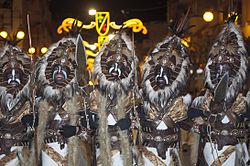- Moros y cristianos
-
Moros y Cristianos (Spanish: [ˈmoɾos i kɾisˈtjanos]) or Moros i Cristians (Valencian: [ˈmɔɾoz i kɾistiˈans]) literally in English Moors and Christians, is a set of festival activities which are celebrated in many towns and cities of Spain, mainly in the southern Valencian Community; according to popular tradition the festivals commemorate the battles, combats and fights between Moors (or Muslims) and Christians during the period known as Reconquista (from the 8th century through the 15th century).
The festivals represent the capture of the city by the Moors and the subsequent Christian reconquest. The people that take part in the festival are usually enlisted in filaes or comparsas (companies that represent the Christian or Moor legions), and for several days, they parade with bombastic costumes loosely inspired by Medieval fashion. Christians wear fur, metallic helmets, and armor, fire loud arquebuses, and ride horses. In contrast, Moors wear ancient Arab costumes, carry scimitars, and ride real camels or elephants. The festival develops among shots of gunpowder, medieval music, and fireworks, and ends with the Christians winning a simulated battle around a castle.
The most well-known Moors and Christians festival takes place in Alcoi (Valencian Community) from 22 to 24 April, around the Feast Day of Saint George (Catalan: Sant Jordi, Spanish: San Jorge). According to legend, after James I of Aragon reconquered the city of Alcoi, the Moors, in turn, tried to recover it shortly after. But, when they were about to start the battle again, Saint George miraculously appeared to the Moors, who were frightened away.
Other remarkable Moors and Christians festivals are celebrated in the towns of Bocairent (Medieval town 1–5 February), La Vila Joiosa (with its desembarc), Villena with approximately 12,000 participants (most crowded festival), Biar, Cocentaina, Crevillent, El Campello, Elda, Muro d'Alcoi, Oliva (third weekend in July), Ontinyent, Orihuela, Petrer, Pollença and some districts of Alicante city. One of the most ancient festival is celebrated in Caudete (nowadays in the Albacete province, but then was part of the Kingdom of Valencia), dated from 1588.
A version of this festival survives in the Philippines in the form of the moro-moro play, staged during fiestas. The show begins with a parade of stars in their colorful costumes. Actors playing Christians wear blue costumes while those playing Moors wear red costumes and are fully ornamented.
See also
External links
- Pictures of Moros y Cristianos in Muro de Alcoy 2006
- Unión Nacional de Entidades Festeras de Moros y Cristianos, Web page of the official organism, in Spanish.
- Fotos Moros y Cristianos, Pictures of Moros y Cristianos festival in La Vila Joiosa.
- Alcoy Foto Pictures of Alcoy and La fiesta de moros y cristianos in Alcoy.
- Moros i Cristians of Alcoi.
- Moros y Cristianos Festival history and today
- MusicaFestera.com Music of Moros y Cristianos
- Moros y Cristianos of Elda.
- Moros y Cristianos of Villena.
- Junta Festera de Moros i Cristians del Campello, Web page of the official organism.
- Comparsa Saudites d'Ontinyent (valencian) (Spanish) (English)
- Tourist information Travel guide and info.
Cultural domain of Valencian Community History Prehistoric Iberia Treasure of Villena · Iberians (Contestani, Edetani and Ilercavones) Lady of Elx · Roman Hispania Lucentum · Visigothic Kingdom · Al-Andalus · Crown of Aragon (Kingdom of Valencia) · Spanish Empire · Spanish transition · Autonomous communityLanguages Sports Cuisine Musical instruments
and typical musicTraditions and feasts Ball de diables · Bonfires of Saint John · Cavalcade of Magi · Correfoc · Falles · Holy Week · Misteri d'Elx · Muixeranga · Moros i cristians · Tomatina · Bou embolatMusic festivals Categories:- Warfare of the Middle Ages
- Spanish culture
- Al-Andalus
- Valencian Community
- Theatre in the Philippines
Wikimedia Foundation. 2010.




